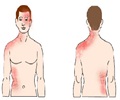Researchers at the University of Utah have found that people prone to herpes simplex virus (HSV) outbreaks are most likely to inherit the susceptibility through their genes.
Researchers at the University of Utah have found that people prone to herpes simplex virus (HSV) outbreaks are most likely to inherit the susceptibility through their genes.
The team has identified a region on the long arm of human chromosome 21 with high odds—at least 1,000-to-1—of being linked to cold sore susceptibility.They further say they have located six specific genes in that chromosomal region that are aspiring for making people prone to outbreaks of cold sores (also called “fever blisters”). Cold sores occur when the herpes virus reactivates from its dormant state within the nerve, infecting the lip, nose, or face.
The study was led by Maurine R. Hobbs, Ph.D., research assistant professor in the Division of Endocrinology and Metabolism.
According to John D. Kriesel, M.D., research associate professor in the U School of Medicine’s Division of Infectious Diseases, the discovery of possible link could lead to the development of new drugs that reduce the frequency of herpes outbreaks.
“One or more of these genes might make excellent targets for new drugs to reduce the number of herpes outbreaks,” said Kriesel.
There are two types of the herpes simplex virus— Type 1 (HSV-1) and type 2 (HSV-2).
Advertisement
For searching the cold sore susceptibility genes, the scientists used linkage analysis, tracing genetic markers in families to spot regions on chromosomes that harbour disease genes.
This study was the first whole-genome study of herpes simplex virus to use linkage analysis, where the scientists assessed 421 people from 39 large Utah families. The families constituted a part of a genomic study called the Utah Genetic Reference Project.
According to how often they experienced cold sore outbreaks, the participants were grouped into four categories. ‘Frequently affected’— HSV-1 infected and two or more outbreaks annually (89 participants), ‘Mildly affected’—HSV-1 infected and two or less outbreaks annually (111), ‘Unaffected’—HSV-1 infected but had never experienced an outbreak (85) and ‘Unknown or HSV uninfected’—could not be categorized (146).
In order to allow the greatest possible distinction in the expression of outbreaks, the researchers compared the “frequently affected” and “unaffected” groups (both proven to be HSV-1 infected). Those participants who couldn’t be categorized were excluded from the linkage analysis, including the 111 mildly affected people.
After collecting all the genetics data, a mathematical analysis determined the odds of a link between cold sores and the long arm of chromosome 21 to be at least 1,000-to-1.
It was found that apart from the possible genetic link other factors are also believed to trigger reactivation of HSV and cold sores. Environmental factors, such as fever, wind, and sunburn, also are thought to play a part. Frequency of HSV outbreaks, is also influenced by Viral factors, like strain and burden of latent infection.
“We didn’t start with the thought that particular genes were important in the search. That helped ensure an unbiased study and led to a completely unexpected result in chromosome 21,” said Kriesel.
The researchers are now looking at the six candidate susceptibility genes to find out which are related to cold sores. Three of those genes look particularly promising to study.
“Finding a drug target to reduce the frequency of cold sores would be even more valuable if we could expand our study results to include genital herpes or herpes keratitis, and that’s something I’d like to do,” said Kriesel.
The study will be published in the upcoming issue of The Journal of Infectious Diseases, and is now available online.
Source-ANI
LIN/K









